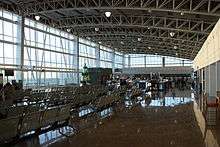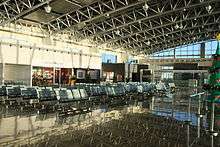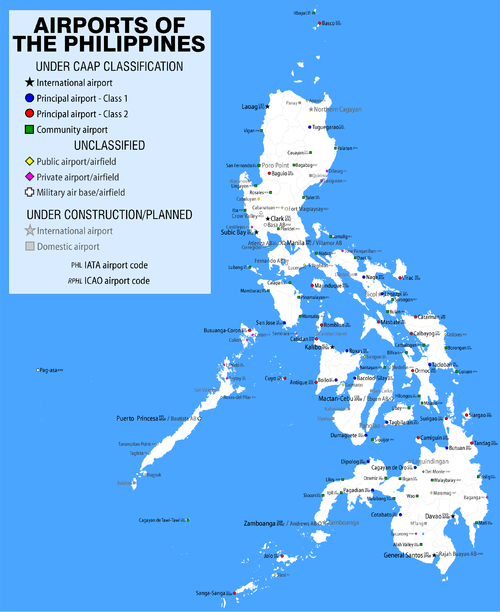Clark International Airport
| Clark International Airport Pangyatung Sulapawan ning Clark (Kapampangan) Paliparang Pandaigdig ng Clark (Filipino) | |||||||||||||||
|---|---|---|---|---|---|---|---|---|---|---|---|---|---|---|---|
 | |||||||||||||||
|
Passenger terminal of Clark International Airport. | |||||||||||||||
| IATA: CRK – ICAO: RPLC | |||||||||||||||
| Summary | |||||||||||||||
| Airport type | Military/Public | ||||||||||||||
| Owner | Bases Conversion and Development Authority[1][2] | ||||||||||||||
| Operator |
Clark International Airport Corporation Philippine Air Force[3] | ||||||||||||||
| Serves | Central Luzon and Greater Manila Area | ||||||||||||||
| Location | Clark Freeport Zone | ||||||||||||||
| Opened | June 16, 1996[4][5] | ||||||||||||||
| Hub for |
Cebu Pacific Philippine Airlines (planned) PAL Express (planned) | ||||||||||||||
| Elevation AMSL | 148 m / 484 ft | ||||||||||||||
| Coordinates | 15°11′09″N 120°33′35″E / 15.18583°N 120.55972°ECoordinates: 15°11′09″N 120°33′35″E / 15.18583°N 120.55972°E | ||||||||||||||
| Website | clarkairport.com | ||||||||||||||
| Map | |||||||||||||||
.svg.png) CRK/RPLC Location in the Philippines | |||||||||||||||
| Runways | |||||||||||||||
| |||||||||||||||
| Statistics (2014) | |||||||||||||||
| |||||||||||||||
Clark International Airport (Kapampangan: Pangyatung Sulapawan ning Clark; Filipino: Paliparang Pandaigdig ng Clark), formerly known as the Diosdado Macapagal International Airport (IATA: CRK, ICAO: RPLC), is an airport that is an international gateway to the Philippines within Clark Freeport Zone, located 43.2 NM (80.0 km; 49.7 mi)[8] northwest of Manila. The airport is located along the border between the cities of Angeles and Mabalacat in the province of Pampanga and is accessible through the Subic-Clark-Tarlac Expressway, which is connected to the North Luzon Expressway.
Clark serves the general vicinity of central and northern Luzon. The name is derived from the former American Clark Air Force Base which was the largest overseas base of the United States Air Force until it was closed in 1991 and handed over to the Government of the Philippines.
The airport is managed and operated by Clark International Airport Corporation (CIAC), a government-owned enterprise; and the southern part of the facility is utilized by the Philippine Air Force as Clark Air Base.[3]
History
In 1993, the former Clark Air Base was reopened as the Clark Special Economic Zone (CSEZ) after the area was cleared from lahar debris from the Mount Pinatubo explosion and a typhoon that followed. During the administration of former President Fidel V. Ramos, it was designated to be the future primary international gateway of the Philippines and the major international airport of Metro Manila and its neighboring provinces when Ninoy Aquino International Airport in Metro Manila has reached full capacity and can no longer be expanded.
In 2003, President Gloria Macapagal-Arroyo renamed Clark International Airport as the Diosdado Macapagal International Airport (DMIA), in memory of her father, former President Diosdado Macapagal, and ordered the Clark International Airport Corporation (CIAC) in February 2007 to fund the US$1.7 billion (PH₱76.5 billion) expansion of DMIA and the approval of a US$2 million (PH₱90 million) study plan financed by the Korean International Cooperation Agency. The first stage of Clark Airport's expansion program, a PH₱130 million terminal expansion, was completed in January 2008 to accommodate more than 2 million passengers annually.[9] In February 2012, the airport's name reverted to Clark International Airport,[10] but the passenger terminal continued to bear Diosdado Macapagal's name.
Terminal Complex
Terminal 1 (Diosdado Macapagal Terminal)


The $3 million (PH₱130 million) expanded Terminal 1 (now called the "Diosdado Macapagal Terminal" since the renaming of the airport back to Clark), designed to accommodate one million to two million passengers annually, was inaugurated by President Arroyo on April 2008 to serve the growing passenger volume due to the entry of foreign and local budget carriers at the airport. Completed in April 2010, the $12 million (PH₱550 million) expansion added a second story, arrival and departure lounges, and two aerobridges to the terminal building. The expansion boosts Clark's capacity to five million.[11] Once Terminal 2 is completed, Terminal 1 will take over all domestic routes.[12]
Future Development
The future international gateway for the country is currently being built at Clark International Airport. It is planned to become one of the world's biggest in terms of terminal size and land area. A high speed railway system will be built to connect the new airport to Metro Manila. Officially, Ninoy Aquino International Airport (NAIA) is the only airport serving the Manila area. However, both NAIA and Clark International Airport (CRK) serve the national capital and surrounding provinces, with CRK catering mostly to low-cost carriers that avail themselves of the lower landing fees than those charged at NAIA.
| Statistics | Terminal 1 | Terminal 1 First Expansion | Terminal 1 Second Expansion[12] | Premier Gateway Terminal 2[13] Phase 1 | Budget Terminal[14] | Terminal 2 Phase 2 | Master Plan Terminal 3 |
|---|---|---|---|---|---|---|---|
Capacity | |||||||
| Completed | Completed | Completed | Completed | 2016 | TBA | 2025 |
Terminal 2
The Terminal 2 of Clark comes in two phases. It will be dedicated to international traffic.[12] It has a total floor area of 35,000 square meters and a 7 million-passenger capacity per year.[17] Total investment for this phase is estimated at US$150 million (PH₱6.75 billion).[12] It includes the expansion of the eastern runway to 4000 meters.,[18] a new runway, a new cargo terminal complex, and a new control tower.[12]
Budget Terminal
On December 16, 2013, it was announced that the Philippines and France are set to sign a memorandum of agreement for the plan and design of the budget terminal, which is expected to be completed in the second quarter of 2016. The terminal will be designed by Aéroports de Paris and it would have a capacity of 15 million passengers per year.[14]
Terminal 3
Terminal 3 is expected to make DMIA handle 80 million passengers a year.[19] When completed, Clark Airport will have:
- 3 parallel runways
- A high-speed train.[20]
- Once completed, it can accommodate 80 million passengers annually,[16] thus becoming one of the largest airports in the world.
- Facility can accommodate the A380 once completed.
Runways
Clark Airport has two 3,200-meter parallel runways, one of which will be extended to 4,000 meters to accommodate new generation wide-bodied aircraft. The runways' descriptions include:[21]
- The primary runway (Runway 02R/20L) has a length of 3,200 meters and a width of 60 meters. It is equipped with various navigational aids and lighting facilities, and it has a Category 1 rating for precision approach.
- The secondary runway (Runway 02L/20R) has the same length as the primary runway (3,200 m) and a width of 45 meters, and it is currently used for Visual Flight Rules (VFR) only since the navigational aids and lighting facilities present in the primary runway have not yet been installed.
Clark Aerotropolis
The Clark International Airport is being pushed to become the Philippine's first aerotropolis[22][23] with businesses and industries relocating to the former American airfield complex. The Clark complex used to be the hub of UPS cargo and Subic Bay was the hub of FedEx cargo until both relocated to China.
Airlines and destinations
Passenger
| Airlines | Destinations |
|---|---|
| Asiana Airlines | Seoul–Incheon |
| Cathay Dragon | Hong Kong |
| Cebu Pacific | Cebu, Hong Kong, Macau, Singapore |
| Emirates | Dubai–International |
| Jin Air | Busan, Seoul–Incheon |
| Philippine Airlines | Seoul–Incheon (Begins January 1, 2017) |
| Philippine Airlines operated by PAL Express | Caticlan (Begins December 16, 2016) |
| Qatar Airways | Doha |
| Tigerair | Singapore |
Cargo
| Airlines | Destinations |
|---|---|
| FedEx Express | Guangzhou, Taipei–Taoyuan |
| UPS Airlines | Shenzhen |
Awards
- Center for Asia Pacific Aviation
Low-Cost Airport of the Year (2006)[24] - Frost & Sullivan Asia Pacific Aerospace and Defense Awards
Airport of the Year (2008) (for airports under 15 million passengers category)[25] - Routes Airport Marketing Awards
Winner (2013) (for 'Under 20 Million' Category)[26]
Ground transportation
Motor vehicle
The Subic-Clark-Tarlac Expressway (SCTEx) provides access through the airport, with two exits: Clark North and Clark South interchange, where the latter leads directly to Clark. Passengers with connecting flights at Ninoy Aquino International Airport in Metro Manila can take North Luzon Expressway which is linked via SCTEx, then passing through Epifanio de los Santos Avenue, Roxas Boulevard and finally onto NAIA Road. The future corridor between NAIA and Clark International Airport is the Metro Manila Skyway Stage 3 from NLEx to SLEx and NAIA Expressway from Skyway and SLEx to NAIA Terminals. The target completion of the NLEx-SLEx elevated expressway link project is 2019.
Park and ride services are provided within the airport as well.[27]
Public transportation
Regular bus services going directly to Metro Manila are served by Partas and Philtranco; although not operating after midnight hours. By 15 January 2013, there will be a newly constructed lounge in TriNoma Mall that will operate 24 hours a day and will be initially offered by Genesis, Five Star, and Philtranco.[28]
Clark is also served by airconditioned jeepneys en route to nearby Dau bus terminal and SM City Clark. Most buses running to the northern provinces of Luzon and back to Metro Manila include a stopover at Dau bus terminal.
Accidents and incidents
- On 21 April 2010, Pacific East Asia Cargo Airlines flight 7815, an Antonov An-12 (UP-AN216), crashed on approach after a fire broke out in flight.[29]
See also
References
- ↑ "BCDA to build Clark International Airport under DOTC Leadership" (Press release). Bases Conversion and Development Authority. 24 October 2011. Retrieved 30 December 2012.
BCDA wrote Sec. Mar Roxas to map out its plans and strategies for major infrastructures under BCDA’s ownership and mandate such as the Clark International Airport.
- ↑ Darwin G. Amojelar (22 October 2011). "BCDA to build Clark International Airport". The Manila Times. Retrieved 30 December 2012.
Casanova emphasized that the BCDA owns the properties and assets of the Clark International Airport Corp. (CIAC) and Clark Development Corp. (CDC) which gives it legal authority to undertake the development of the airport.
- 1 2 "Clark Air Base". Philippine Air Force. Retrieved 31 December 2012.
Though the air facility principally handled civilian air traffic (it was planned to replace Ninoy Aquino International Airport as Metro Manila's primary airport), the Philippine Air Force maintained a presence there, and part of it was still known as Clark Air Base.
- ↑ "2007 Annual Report" (PDF). Clark International Airport Official Website. Clark International Airport Corporation. p. 16. Retrieved 17 June 2016.
- ↑ "Remembering CRK's 1st flight 20 years ago, June 16, 1996.". Facebook. Clark International Airport Corporation. Retrieved 17 June 2016.
- ↑ "Vital Information" (PDF). Clark International Airport Corporation. Retrieved 8 June 2016.
- ↑ "PAF Air bases". Philippine Air Force. Retrieved 1 January 2013.
- ↑ Baluyut, Joelyn (10 October 2012). "NAIA flights diverted to Clark". Philippine Information Agency. Retrieved 13 January 2013.
- ↑ Sunstar.com Archived 28 September 2008 at the Wayback Machine.
- ↑ "Clark airport name-change plan sparks debate". ABS-CBN News. 2012-02-28. Retrieved 2013-08-24.
- ↑ "Flightglobal.com". Flightglobal.com. 2010-01-25. Retrieved 2013-08-24.
- 1 2 3 4 5 6 Citrinot, Luc (2010-01-08). "Eturbonews.com". Eturbonews.com. Retrieved 2013-08-24.
- ↑ Diosdado Macapagal Airport posts 110% jump in passenger volume. - Journal, Magazine, Article, Periodical
- 1 2 3 Agcaoili, Lawrence (2013-12-16). "Phl, France ink design pact for Clark terminal". The Philippine Star. Retrieved 2013-12-28.
- ↑ Bright Future for DMIA Archived 28 November 2007 at the Wayback Machine.
- 1 2 3 Laude, Pete (July 22, 2014). "Clark airport opens modern passenger wing; new LCC terminal proposed to NEDA in August". Philippine Information Agency. Retrieved October 22, 2014.
- ↑ Businessmirror.com.ph Archived 25 February 2012 at the Wayback Machine.
- ↑ Sunstar.com Archived 15 September 2004 at the Wayback Machine.
- ↑ Manilatimes.net
- ↑ "OP.gov.ph". OP.gov.ph. 2013-05-09. Retrieved 2013-08-24.
- ↑ Clarkairport.com Archived 10 February 2009 at the Wayback Machine.
- ↑ http://www.mb.com.ph/aerotropolis-to-generate-job-opportunities/
- ↑ http://www.interaksyon.com/business/55505/clark-wants-to-be-philippines-first-aerotropolis
- ↑ "DMIA bags Low-Cost Airport Award".
- ↑ "DMIA awarded 'Airport of the Year' by global consulting group".
- ↑ "Routes Asia 2013 :: Routes Airport Marketing Awards". Routesonline. Retrieved 2013-08-24.
- ↑ "Frequently Asked Questions". Clark International Airport Corporation. Retrieved 13 January 2013.
- ↑ Pavia, Joey (13 January 2013). "CIA eyes 2M passengers in 2013, launches Clark-TriNoma bus route". The Business Mirror. Retrieved 13 January 2013.
- ↑ Simon Hradecky (21 April 2010). "Crash: ATMA AN12 at Mexico on April 21, 2010, fire on board". The Aviation Herald. Retrieved 22 April 2010.
External links
| Wikimedia Commons has media related to Clark International Airport. |
- Official website
- Clark Development Corporation
- Current weather for RPLC at NOAA/NWS
- Accident history for CRK at Aviation Safety Network
- http://www.clark-airport.com flight information, taxis, location and parking map and general information.

